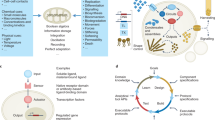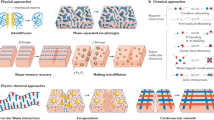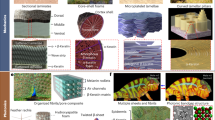Abstract
Biological systems spontaneously convert energy input into the actions necessary to survive. Motivated by the efficacy of these processes, researchers aim to forge materials systems that exhibit the self-sustained and autonomous functionality found in nature. Success in this effort will require synthetic analogues of the following: a metabolism to generate energy, a vasculature to transport energy and materials, a nervous system to transmit ‘commands’, a musculoskeletal system to translate commands into physical action, regulatory networks to monitor the entire enterprise, and a mechanism to convert ‘nutrients’ into growing materials. Design rules must interconnect the material’s structural and kinetic properties over ranges of length (that can vary from the nano- to mesoscale) and timescales to enable local energy dissipations to power global functionality. Moreover, by harnessing dynamic interactions intrinsic to the material, the system itself can perform the work needed for its own functionality. Here, we assess the advances and challenges in dissipative materials design and at the same time aim to spur developments in next-generation functional, ‘living’ materials.
This is a preview of subscription content, access via your institution
Access options
Access Nature and 54 other Nature Portfolio journals
Get Nature+, our best-value online-access subscription
$29.99 / 30 days
cancel any time
Subscribe to this journal
Receive 12 print issues and online access
$259.00 per year
only $21.58 per issue
Buy this article
- Purchase on Springer Link
- Instant access to full article PDF
Prices may be subject to local taxes which are calculated during checkout






Similar content being viewed by others
References
Bissell, R. A., Córdova, E., Kaifer, A. E. & Stoddart, J. F. A chemically and electrochemically switchable molecular shuttle. Nature 369, 133–137 (1994).
Balzani, V., Credi, A., Raymo, F. & Stoddart, J. Artificial molecular machines. Angew. Chem. Int. Ed. 39, 3348–3391 (2000).
Feringa, B. L., van Delden, R. A., Koumura, N. & Geertsema, E. M. Chiroptical molecular switches. Chem. Rev. 100, 1789–1816 (2000).
Chatterjee, M. N., Kay, E. R. & Leigh, D. A. Beyond switches: ratcheting a particle energetically uphill with a compartmentalized molecular machine. J. Am. Chem. Soc. 128, 4058–4073 (2006).
Shirai, Y., Osgood, A. J., Zhao, Y., Kelly, K. F. & Tour, J. M. Directional control in thermally driven single-molecule nanocars. Nano Lett. 5, 2330–2334 (2005).
Kudernac, T. et al. Electrically driven directional motion of a four-wheeled molecule on a metal surface. Nature 479, 208–211 (2011).
Samudra, S. et al. Self-powered enzyme micropumps. Nat. Chem. 6, 415–422 (2014).
Balazs, A. C., Fischer, P. & Sen, A. Intelligent nano/micromotors: using free energy to fabricate organized systems driven far from equilibrium. Acc. Chem. Res. 51, 2979 (2018).
Karshalev, E., Esteban-Fernandez de Avila, B. & Wang, J. Micromotors for ‘chemistry-on-the-fly’. J. Am. Chem. Soc. 140, 3810–3820 (2018).
Fernández‐Medina, M., Ramos‐Docampo, M. A., Hovorka, O., Salgueiriño, V. & Städler, B. Recent advances in nano‐ and micromotors. Adv. Funct. Mater. 30, 1908283 (2020).
Walther, A. Viewpoint: From responsive to adaptive and interactive materials and materials systems: a roadmap. Adv. Mater. 32, 1905111 (2019).
Cafferty, B. J. et al. Robustness, entrainment, and hybridization in dissipative molecular networks, and the origin of life. J. Am. Chem. Soc. 141, 8289–8295 (2019).
Semenov, S. N. et al. Autocatalytic, bistable, oscillatory networks of biologically relevant organic reactions. Nature 537, 656–660 (2016).
Mukherjee, S. & Bassler, B. L. Bacterial quorum sensing in complex and dynamically changing environments. Nat. Rev. Microbiol. 17, 371–382 (2019).
Shum, H. & Balazs, A. C. Synthetic quorum sensing in model microcapsule colonies. Proc. Natl Acad. Sci. USA 114, 8475–8480 (2017).
Kondepudi, D. & Prigogine, I. Modern Thermodynamics: from Heat Engines to Dissipative Structures (Wiley, 2014).
Turing, A. M. The chemical basis of morphogenesis. Philos. Trans. R. Soc. B 237, 37–72 (1952).
Eckert, K., Bestehorn, M. & Thess, A. Square cells in surface-tension-driven Bénard convection: experiment and theory. J. Fluid Mech. 356, 155–197 (1998).
Hanczyc, M. M., Fujikawa, S. M. & Szostak, J. W. Experimental models of primitive cellular compartments: encapsulation, growth, and division. Science 302, 618–622 (2003).
Chiu, D. T. et al. Chemical transformations in individual ultrasmall biomimetic containers. Science 283, 1892–1895 (1999).
Tu, B. P., Kudlicki, A., Rowicka, M. & McKnight, S. L. Logic of the yeast metabolic cycle: temporal compartmentalization of cellular processes. Science 310, 1152–1158 (2005).
Balazs, A., C. et al. Designing Biomimetic, Dissipative Material Systems (US Department of Energy Office of Scientific and Technical Information, 2016).
Eder, M., Amini, S. & Fratzl, P. Biological composites—complex structures for functional diversity. Science 362, 543–547 (2018).
Oxman, N. Material-Based Design Computation. PhD thesis, Massachusetts Institute of Technology (2010).
Costa, J., Bader, C., Sharma, S., Xu, J. & Oxman, N. Spinning smooth and striated: integrated design and digital fabrication of bio-homeomorphic structures across scales. In Proc. IASS Annual Symposia, IASS 2018 Boston Symposium: Reimagining Material and Design (International Association for Shell and Spatial Structures (IASS), 2018).
Rus, D. & Tolley, M. T. Design, fabrication and control of soft robots. Nature 521, 467–475 (2015).
Trudy, R. L. Designing soft robots as robotic materials. Acc. Mater. Res. 2, 854–857 (2021).
Yasa, O. et al. An overview of soft robotics. Annu. Rev. Control Robot. Auton. Syst. 6, 1–29 (2023).
Roy, D., Cambre, J. N. & Sumerlin, B. S. Future perspectives and recent advances in stimuli-responsive materials. Prog. Polym. Sci. 35, 278–301 (2010).
McCracken, J. M., Donovan, B. R. & White, T. J. Materials as machines. Adv. Mater. 32, 1906564 (2020).
Liu, X. et al. Recent advances in stimuli‐responsive shape‐morphing hydrogels. Adv. Funct. Mater. 32, 2203323 (2022).
Stuart, M. A. C. et al. Emerging applications of stimuli-responsive polymer materials. Nat. Mater. 9, 101–113 (2010).
Liu, J., Gao, Y., Lee, Y.-J. & Yang, S. Responsive and foldable soft materials. Trends Chem. 2, 107–122 (2020).
Kang, M. Sublime Dreams of Living Machines: the Automaton in the European Imagination (Harvard University Press, 2011).
Yoshida, R. & Ueki, T. Evolution of self-oscillating polymer gels as autonomous polymer systems. NPG Asia Mater. 6, e107 (2014).
van Roekel, H. W. H. et al. Programmable chemical reaction networks: emulating regulatory functions in living cells using a bottom-up approach. Chem. Soc. Rev. 44, 7465–7483 (2015).
Semenov, S. N. et al. Rational design of functional and tunable oscillating enzymatic networks. Nat. Chem. 7, 160–165 (2015).
Wong, A. S. Y. & Huck, W. T. S. Grip on complexity in chemical reaction networks. Beilstein J. Org. Chem. 13, 1486–1497 (2017).
Fusi, G., Del Giudice, D., Skarsetz, O., Di Stefano, S. & Walther, A. Autonomous soft robots empowered by chemical reaction networks. Adv. Mater. 35, 2209870 (2023).
Grzybowski, B. & Huck, W. The nanotechnology of life-inspired systems. Nat. Nanotechnol. 11, 585–592 (2016).
Baytekin, B., Cezan, S. D., Baytekin, H. T. & Grzybowski, B. A. Artificial heliotropism and nyctinasty based on optomechanical feedback and no electronics. Soft Robot. 5, 93–98 (2018).
Sharma, C. & Walther, A. Self-regulating colloidal co-assemblies that accelerate their own destruction via chemo-structural feedback. Angew. Chem. Int. Ed. 61, e2022015 (2022).
Morim, D. R. et al. Opto-chemo-mechanical transduction in photoresponsive gels elicits switchable self-trapped beams with remote interactions. Proc. Natl Acad. Sci. USA 117, 3953–3959 (2020).
Elowitz, M. B. & Leibler, S. A synthetic oscillatory network of transcriptional regulators. Nature 403, 335–338 (2000).
Shklyaev, O. E. & Balazs, A. C. Lifelike behavior of chemically oscillating mobile capsules. Matter 5, 3464–3484 (2022).
He, X. et al. Creating homeostasis in synthetic materials via self-regulating chemo-mechano-chemical systems with built-in feedback loops. Nature 487, 214–218 (2012).
Yuan, P. et al. A programmable soft chemomechanical actuator exploiting a catalyzed photochemical water-oxidation reaction. Soft Matter 13, 7312–7317 (2017).
Grinthala, A. & Aizenberg, J. Adaptive all the way down: building responsive materials from hierarchies of chemomechanical feedback. Chem. Soc. Rev. 42, 7072–7085 (2013).
Ma, X. et al. Reversed Janus micro/nanomotors with internal chemical engine. ACS Nano 10, 8751–8759 (2016).
Xu, L., Wang, A., Li, X. & Oh, K. W. Passive micropumping in microfluidics for point-of-care testing. Biomicrofluidics 14, 031503 (2020).
Yuan, H., Liu, X., Wang, L. & Ma, X. Fundamentals and applications of enzyme powered micro/nano-motors. Bioact. Mater. 6, 1727–1749 (2021).
Ortiz-Rivera, I., Shum, H., Agrawal, A., Sen, A. & Balazs, A. C. Convective flow reversal in self-powered enzyme micropumps. Proc. Natl Acad. Sci. USA 113, 2585–2590 (2016).
Valdez, L., Shum, H., Ortiz-Rivera, I., Balazs, A. C. & Sen, A. Solutal and thermal buoyancy effects in self-powered phosphatase micropumps. Soft Matter 13, 2800–2807 (2017).
Shklyaev, O. E., Shum, H., Sen, A. & Balazs, A. C. Harnessing surface-bound enzymatic reactions to organize microcapsules in solution. Sci. Adv. 2, e1501835 (2016).
Laskar, A., Shklyaev, O. E. & Balazs, A. C. Designing self-propelled, chemically active sheets: wrappers, flappers and creepers. Sci. Adv. 4, eaav1745 (2018).
Manna, R. K., Shklyaev, O. E., Stone, H. A. & Balazs, A. C. Chemically controlled shape-morphing of elastic sheets. Mater. Horiz. 7, 2314–2327 (2020).
Manna, R. K., Shklyaev, O. E. & Balazs, A. C. Chemically driven multimodal locomotion of active, flexible sheets. Langmuir 39, 780–789 (2023).
Laskar, A., Manna, R. K., Shklyaev, O. E. & Balazs, A. C. Computer modeling reveals modalities to actuate mutable, active matter. Nat. Commun. 13, 2689 (2022).
Mathesh, M., Bhattarai, E. & Yang, W. 2D active nanobots based on soft nanoarchitectonics powered by an ultralow fuel concentration. Angew. Chem. Int. Ed. 61, e202113801 (2021).
Kinstlinger, I. S. & Miller, J. S. 3D-printed fluidic networks as vasculature for engineered tissue. Lab Chip 16, 2025–2043 (2016).
Yang, C., Yu, Y., Wang, X., Wang, Q. & Shang, L. Cellular fluidic-based vascular networks for tissue engineering. Eng. Regen. 2, 171–174 (2021).
Wu, W. et al. Direct-write assembly of biomimetic microvascular networks for efficient fluid transport. Soft Matter 6, 739–742 (2010).
O’Connor, C., Brady, E., Zheng, Y., Moore, E. & Stevens, K. R. Engineering the multiscale complexity of vascular networks. Nat. Rev. Mater. 7, 702–716 (2022).
Wehner, M. et al. An integrated design and fabrication strategy for entirely soft, autonomous robots. Nature 536, 451–455 (2016).
Taylor, J. M. et al. Biomimetic and biologically compliant soft architectures via 3D and 4D assembly methods: a perspective. Adv. Mater. 34, 2108391 (2022).
Truby, R. L. et al. Soft somatosensitive actuators via embedded 3D printing. Adv. Mater. 30, 1706383 (2018).
Valentine, A. D. et al. Hybrid 3D printing of soft electronics. Adv. Mater. 29, 1703817 (2017).
Maiti, S., Shklyaev, O. E., Balazs, A. C. & Sen, A. Self-organization of fluids in a multi-enzymatic pump system. Langmuir 35, 3724–3732 (2019).
Qian, S., Wang, X. & Yan, W. Piezoelectric fibers for flexible and wearable electronics. Front. Optoelectron. 16, 3 (2023).
Ning, X. et al. Mechanically active materials in three-dimensional mesostructures. Sci. Adv. 4, eaat8313 (2018).
Ni, X. et al. Soft shape-programmable surfaces by fast electromagnetic actuation of liquid metal networks. Nat. Commun. 13, 5576 (2022).
Kim, Y., van den Berg, J. & Crosby, A. J. Autonomous snapping and jumping polymer gels. Nat. Mater. 20, 1695–1701 (2021).
Zhang, H. et al. Feedback-controlled hydrogels with homeostatic oscillations and dissipative signal transduction. Nat. Nanotechnol. 17, 1303–1310 (2022).
Li, S. et al. Self-regulated non-reciprocal motions in single-material microstructures. Nature 605, 76–83 (2022).
Eckstein, T. F., Vidal-Henriquez, E., Bae, A. J. & Gholami, J. Spatial heterogeneities shape the collective behavior of signaling amoeboid cells. Sci. Signal. 13, eaaz3975 (2020).
Singer, G., Araki, T. & Weijer, C. J. Oscillatory cAMP cell–cell signalling persists during multicellular Dictyostelium development. Commun. Biol. 2, 139 (2019).
Kim, Y. K., Wang, X., Mondkar, P., Bukusoglu, E. & Abbott, N. L. Self-reporting and self-regulating liquid crystals. Nature 557, 539–544 (2018).
Chen, M. et al. Living additive manufacturing: transformation of parent gels into diversely functionalized daughter gels made possible by visible light photo-redox catalysis. ACS Cent. Sci. 3, 124–134 (2017).
Singh, A., Kuksenok, O., Johnson, J. A. & Balazs, A. C. Photo-regeneration of severed gel with iniferter-mediated photo-growth. Soft Matter 13, 1978–1987 (2017).
Beziau, A. et al. Photoactivated structurally tailored and engineered macromolecular (STEM) gels as precursors for materials with spatially differentiated mechanical properties. Polymer 126, 224–230 (2017).
Cuthbert, J. et al. Transformable materials: structurally tailored and engineered macromolecular (STEM) gels by controlled radical polymerization. Macromolecules 51, 3808–3817 (2018).
Xue, L. et al. Light-regulated growth from dynamic swollen substrates for making rough surfaces. Nat. Commun. 11, 963 (2020).
Xiong, X., Wang, S., Xue, L., Wang, H. & Cui, J. Growing strategy for postmodifying cross-linked polymers’ bulky size, shape, and mechanical properties. ACS Appl. Mater. Interfaces 14, 8473–8481 (2022).
Chatterjee, R. et al. Controllable growth of interpenetrating or random copolymer networks. Soft Matter 17, 7177–7187 (2021).
Matsuda, T., Kawakami, R., Namba, R., Nakajima, T. & Gong, J. P. Mechanoresponsive self-growing hydrogels inspired by muscle training. Science 363, 504–508 (2019).
Dou, Y., Dhatt-Gauthier, K. & Bishop, K. J. M. Thermodynamic costs of dynamic function in active soft matter. Curr. Opin. Solid State Mater. Sci. 23, 28–40 (2019).
Chen, L. et al. The energy flow and mechanical modeling of soft chemo-mechanical machines. J. Appl. Phys. 124, 165111 (2018).
Zhao, X. Multi-scale multi-mechanism design of tough hydrogels: building dissipation into stretchy networks. Soft Matter 10, 672–687 (2014).
Ford, M. J., Ohm, Y., Chin, K. & Majidi, C. Composites of functional polymers: toward physical intelligence using flexible and soft materials. J. Mater. Res. 37, 2–24 (2022).
Bensaude-Vincent, B. Materials as Machines 101–111 (Boston Studies in the Philosophy and History of Science Vol. 274, Springer, 2010).
Sitti, M. Physical intelligence as a new paradigm. Extreme Mech. Lett. 46, 101340 (2021).
Yasuda, H. et al. Mechanical computing. Nature 598, 39–48 (2021).
McEvoy, M. A. & Correll, N. Materials science. Materials that couple sensing, actuation, computation, and communication. Science 347, 1261689 (2015).
Bénazet, J.-D. & Zeller, R. Vertebrate limb development: moving from classical morphogen gradients to an integrated 4-dimensional patterning system. Cold Spring Harb. Perspect. Biol. 1, 001339 (2009).
Cazimoglu, I., Booth, M. J. & Bayley, H. A lipid-based droplet processor for parallel chemical signals. ACS Nano 15, 20214–20224 (2021).
Zhang, J. et al. Light-powered, fuel-free oscillation, migration, and reversible manipulation of multiple cargo types by micromotor swarms. ACS Nano 17, 251–262 (2022).
Manna, R. K., Laskar, A., Shklyaev, O. E. & Balazs, A. C. Harnessing the power of chemically active sheets in solution. Nat. Rev. Phys. 4, 125–137 (2022).
Elani, Y., Law, R. & Ces, O. Vesicle-based artificial cells as chemical microreactors with spatially segregated reaction pathways. Nat. Commun. 5, 5305 (2014).
Fang, Y., Yashin, V. V., Levitan, S. P. & Balazs, A. C. Pattern recognition with ‘materials that compute’. Sci. Adv. 2, E1601114 (2016).
Fang, Y., Yashin, V. V., Levitan, S. P. & Balazs, A. C. Designing self-powered materials systems that perform pattern recognition. Chem. Commun. 53, 7692–7706 (2017).
Jing, L., Li, K., Yang, H. & Chen, P.-Y. Recent advances in integration of 2D materials with soft matter for multifunctional robotic materials. Mater. Horiz. 7, 54–70 (2020).
Buckner, T. L., Bilodeau, R. A., Kim, S. Y. & Kramer-Bottiglio, R. Roboticizing fabric by integrating functional fibers. Proc. Natl Acad. Sci. USA 17, 25360–25369 (2020).
Hassani, F. A. et al. Smart materials for smart healthcare—moving from sensors and actuators to self-sustained nanoenergy nanosystems. Smart Mater. 1, 92–124 (2020).
Cui, H. et al. Design and printing of proprioceptive three-dimensional architected robotic metamaterials. Science 376, 1287–1293 (2022).
Acknowledgements
A.C.B. thanks the US Department of Energy, Office of Science, Office of Basic Energy Sciences for DOE grant number DE-SC0012348.
Author information
Authors and Affiliations
Corresponding author
Ethics declarations
Competing interests
The authors declare no competing interests.
Peer review
Peer review information
Nature Nanotechnology thanks Andreas Walther and the other, anonymous, reviewer(s) for their contribution to the peer review of this work.
Additional information
Publisher’s note Springer Nature remains neutral with regard to jurisdictional claims in published maps and institutional affiliations.
Rights and permissions
Springer Nature or its licensor (e.g. a society or other partner) holds exclusive rights to this article under a publishing agreement with the author(s) or other rightsholder(s); author self-archiving of the accepted manuscript version of this article is solely governed by the terms of such publishing agreement and applicable law.
About this article
Cite this article
Shklyaev, O.E., Balazs, A.C. Interlinking spatial dimensions and kinetic processes in dissipative materials to create synthetic systems with lifelike functionality. Nat. Nanotechnol. 19, 146–159 (2024). https://doi.org/10.1038/s41565-023-01530-z
Received:
Accepted:
Published:
Issue Date:
DOI: https://doi.org/10.1038/s41565-023-01530-z



